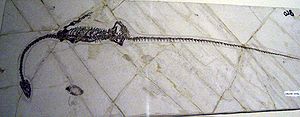Hyphalosaurus
| Hyphalosaurus | ||||||||||||
|---|---|---|---|---|---|---|---|---|---|---|---|---|

Fossil of Hyphalosaurus baitaigouensis in the Hong Kong Science Museum. |
||||||||||||
| Temporal occurrence | ||||||||||||
| Lower Cretaceous | ||||||||||||
| Locations | ||||||||||||
|
||||||||||||
| Systematics | ||||||||||||
|
||||||||||||
| Scientific name | ||||||||||||
| Hyphalosaurus | ||||||||||||
| Gao , Tang & Wang , 1999 |
Hyphalosaurus is the most common Choristodere (an extinct reptile) of the Jehol biota . He lived in the Lower Cretaceous.
features
Hyphalosaurus was 116 cm long, had a small skull with numerous needle-shaped teeth in the pointed snout, 13 rows of ribs, 20 rows of abdominal ribs , 19 cervical vertebrae, 16 to 17 vertebrae, three sacral vertebrae and over 55 caudal vertebrae. Its neck and tail were very long, eight inches in the case of the neck. In general, Hyphalosaurus was well adapted to aquatic life and ate fish. In fact, fish of the genus Lycoptera have been spotted on a stone slab near the mouth of a specimen of Hyphalosaurus.
species
Two types are known:
- Hyphalosaurus lingyuanensis GAO, TANG, WANG 1999 ( Syn . : Sinohydrosaurus lingyuanensis LI, ZHANG, JI, 1999) and
- Hyphalosaurus baitaigouensis JI et al., 2004.
Hyphalosaurus fossils have so far been found in Fanzhangi near Lingyuan and in Wangjiagou , Wanfotang, and Hejiaxin in Yixian County .
literature
- Mee-mann Chang (Ed.): The Jehol Fossils. The Emergence of Feathered Dinosaurs, Beaked Birds and Flowering Plants. Academic Press, Amsterdam et al. 2008, ISBN 978-0-12-374173-8 .